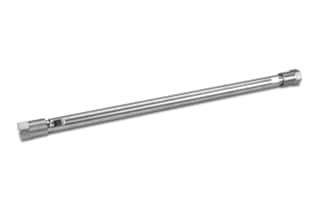
Waters Ultrahydrogel Columns contain a sophisticated aqueous-compatible gel column for analytical and preparative separations of water-soluble polymers. The gel is a cross-linked hydroxylated polymer and contains some residual carboxyl functionality. Ultrahydrogel DP contains some residual amine functionality. Compounds normally characterized include oligomers and biological substances such as polysaccharides, nucleic acids, proteins, and peptides.
|
Chemistry |
SEC |
|
Separation Mode |
Gel Filtration (aqueous) |
|
Particle Substrate |
Polymer |
|
pH Range Min |
2 pH |
|
pH Range Max |
12 pH |
|
Temperature Limits |
10 - 80C |
|
Molecular Weight Range Min |
1000 |
|
Molecular Weight Range Max |
80000 |
|
Particle Shape |
Spherical |
|
Particle Size |
6 µm |
|
Endfitting Type |
Waters |
|
Pore Size |
250 Å |
|
Format |
Column |
|
Packing Solvent |
Water |
|
System |
HPLC |
|
Technique |
SEC |
|
USP Classification |
L37 |
|
Inner Diameter |
7.8 mm |
|
Length |
300 mm |
|
UNSPSC |
41115709 |
|
Application |
Gel Filtration |
|
Brand |
Ultrahydrogel |
|
Product Type |
Columns |
|
Units per Package |
1 pk |

Ultrahydrogel Column, 250Å, 6 µm, 7.8 mm X 300 mm, 1K - 80K, 1/pk
As a sophisticated aqueous-compatible gel column, the Waters Ultrahydrogel Column is ideal for analytical and preparative separations of water-soluble polymers. The gel in these columns is a cross-linked hydroxylated polymer that contains some residual amine functionality. A large range of compounds can be characterized, including oligomers, oligosaccharides, and biological substances like polysaccharides, nucleic acids, proteins, and peptides. Additionally, cationic, anionic, and amphoteric polymers can be characterized.
With measurements of 7.8 x 300 mm, these high-resolution columns are superior to other conventional aqueous SEC Columns in a number of ways. The Ultrahydrogel Column works across a wide pH range of 2-12 and offers greater flexibility for the mobile phase while causing minimal non-size exclusion effects. They offer compatibility with high concentrations of organic solvents (up to 20% organic, 50% organic when the mobile phase is introduced by the gradient. Use of the Ultrahydrogel Column provides high resolution, low adsorption, and supports a wide range of molecular weight separations within a temperature range of 10 C to 80 C.
Compatible with the Ultrahydrogel Guard Column, 125Å, 6 µm, 6 mm X 40 mm, 1K - 500K, 1/pk, this column assures stability, lifetime, and performance that you can count on in a range of physical, chemical, and biological environments. The advanced GPC and SEC analysis made possible by Ultrahydrogel Columns makes use of Waters’ novel and proprietary lab equipment, instrumentation, packing materials, and technology. Waters are market leaders in GPC analysis and all products are manufactured under strict guidelines based on the ISO, FDA, and cGMP recommendations.
How Should Ultrahydrogel Columns Be Stored?
For short-term storage of a few days or less, columns can be stored at room temperature, away from direct sunlight and corrosive gases. If the solvent doesn’t contain buffers or other harmful salts like halogens, first remove the column from the system and seal both ends with the provided end cap fittings. If it does not contain buffers etc, rinse the column using distilled water, then remove the column from the system and seal with the provided end cap fittings. If you are storing the column for more than three days, first replace any solvent with distilled water before removing the column from the system and sealing both ends. It is recommended you add sodium azide (0.05%) to the water for storage periods exceeding 72 hours. Store at room temperature, avoiding direct sunlight and corrosive gases.